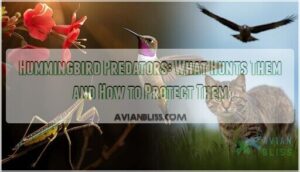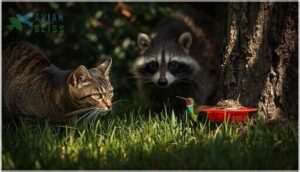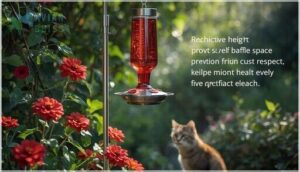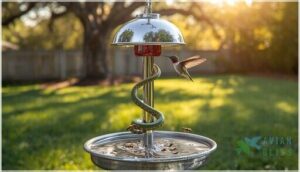This site is supported by our readers. We may earn a commission, at no cost to you, if you purchase through links.
A praying mantis perched on a feeder doesn’t look particularly dangerous—until it strikes with lightning speed and captures a hummingbird mid-hover. It’s a jarring reminder that these aerial acrobats, despite their speed and agility, face threats from predators both large and small.
Domestic cats account for billions of bird deaths annually, including hummingbirds, while sharp-shinned hawks execute precision strikes during flight. But the predator roster doesn’t stop there. Snakes climb to nests under cover of darkness, bullfrogs leap from pond edges to snatch hovering birds, and even large spiders spin webs that can ensnare low-flying hummingbirds.
Understanding which animals pose the greatest risks—and why—gives you the knowledge to create safer spaces where these extraordinary birds can thrive without constantly looking over their shoulders.
Table Of Contents
- Key Takeaways
- What Animals Prey on Hummingbirds?
- Mammals That Threaten Hummingbirds
- Birds Known to Hunt Hummingbirds
- Insects and Spiders as Hummingbird Predators
- Reptiles and Amphibians Preying on Hummingbirds
- How to Protect Hummingbirds From Predators
- Frequently Asked Questions (FAQs)
- What is a hummingbird’s biggest enemy?
- What birds protect hummingbirds?
- What scares hummingbirds away?
- Do squirrels eat hummingbirds?
- How do weather conditions affect hummingbird predators?
- What are nocturnal threats to hummingbirds?
- Can hummingbirds recognize specific predator species?
- How does urbanization influence hummingbird predation?
- Do hummingbirds avoid certain plants due to predators?
- Do hummingbirds have any defenses against predators?
- Conclusion
Key Takeaways
- Hummingbirds face predation from an unexpectedly diverse range of hunters—domestic cats kill billions of birds annually, while praying mantises, large spiders, and bullfrogs use ambush tactics at feeders and water sources to capture these fast-moving birds.
- Strategic feeder placement makes a measurable difference in survival rates—positioning feeders at least five feet high with steel baffles, maintaining open sightlines while staying within ten feet of dense native shrubs, and keeping feeders away from climbing routes drastically reduces predation risk.
- Corvids like jays, crows, and ravens pose serious threats to nesting success rather than adult birds, using their intelligence and memory to locate camouflaged nests near feeders and raid them for eggs and nestlings.
- Keeping cats indoors is the single most impactful action you can take to protect hummingbirds, as free-ranging cats are responsible for an estimated 2.4 billion bird deaths annually in the United States alone.
What Animals Prey on Hummingbirds?
Hummingbirds face threats from a surprisingly diverse group of predators, ranging from the obvious to the downright unexpected. You might be familiar with some of the usual suspects—cats and hawks come to mind—but there’s a whole cast of hunters that includes insects, reptiles, and even other birds.
Let’s look at the main categories of animals that pose a real risk to these tiny, fast-moving targets.
Mammalian Predators
When you think about predator-prey dynamics, mammals might not be the first threat that comes to mind for hummingbirds—but they’re surprisingly significant. From domestic cat attacks to mammal habitat invasion by raccoons and skunks, these warm-blooded hunters shape wildlife conservation strategies in ways you can’t ignore.
Understanding the role of bird predators is essential for protecting hummingbirds from various threats. Protecting hummingbirds from predators means understanding these wildlife protection strategies.
- Domestic cats kill billions of birds annually through feral cat impact
- Squirrels and chipmunks raid vulnerable nests opportunistically
- Raccoons climb feeders at night
- Rodents consume eggs and nestlings
- Skunks depredate multiple nests in single foraging bouts
Avian Predators
Birds of prey pose some of the most dramatic avian threats to hummingbirds. Sharp-shinned hawks and kestrels specialize in raptor attacks during flight, while owls hunt at dawn and dusk near your bird feeder. Crows and ravens act as nest raiders, targeting eggs and nestlings.
These flying hunters demonstrate that danger comes from above—sometimes from species you’d never suspect of preying on hummingbirds. Hummingbirds must be constantly aware of their natural predators list to survive.
Reptilian and Amphibian Predators
Reptiles and amphibians bring wildlife threats closer to the ground. Snakes—especially rat snakes—excel at climbing to nests and ambushing adults at feeders, making snake attacks surprisingly common.
Bullfrogs leap from pond edges to snatch hovering birds, demonstrating frog predation you wouldn’t expect from an amphibian.
Large lizards raid nests and lurk near flowers, adding lizard threats to your hummingbird’s daily reptile encounters in warmer regions.
Insect and Arthropod Predators
You mightn’t expect insect predators to threaten a bird, but praying mantises stationed on feeders strike with lightning speed—capturing hummingbirds in up to 30% of close encounters.
Large spiders spin orbweaver webs exceeding a meter wide, ensnaring low-flying birds in silk strong enough to hold them.
Dragonfly attacks intercept birds mid-flight, while hornet threats and aggressive wasps create dangerous feeding zones, forcing hummingbirds into riskier arachnid predator territory.
Mammals That Threaten Hummingbirds
You might be surprised to learn that some of the biggest threats to hummingbirds aren’t exotic predators—they’re animals you see in your own backyard every day. Mammals pose a real danger to these tiny birds, whether they’re hunting by instinct, raiding nests for an easy meal, or just disrupting critical feeding areas.
Let’s look at the main mammalian predators you need to watch out for.
Domestic and Feral Cats
Domestic cats rank among the most impactful hummingbird predators in residential areas, with studies estimating they kill 1.3 to 4.0 billion birds annually across the United States. Cat behavior combines stealth, agility, and patience—even well-fed pets hunt by instinct. Urban hunting pressure intensifies where cat population density peaks:
- Free-roaming cats concentrate near housing and feeders
- Feral cat impact extends 145–335 meters from buildings
- Nighttime raids target roosting birds and nests
- Wildlife conservation efforts emphasize indoor confinement
Squirrels, Chipmunks, and Rodents
You mightn’t expect it, but squirrels and chipmunks pose real threats to hummingbirds. These rodents are notorious nest raiders—one British study found squirrels responsible for 11% of woodland nest predation events.
They’ll climb feeder poles to steal nectar, displace feeding hummingbirds, and occasionally snatch weak or juvenile birds.
Effective rodent deterrents include baffles, strategic feeder placement, and separate squirrel feeders to redirect their attention.
Raccoons and Other Mammals
Raccoons rank among the most efficient nest predators you’ll encounter—in some regions, they’re responsible for up to 79% of nest failures. These dexterous climbers raid feeders at night, destroy habitat, and consume eggs or nestlings in a single visit.
Effective wildlife management includes raccoon-resistant baffles, bringing feeders indoors after dark, and installing predator guards to strengthen your hummingbird defense strategy.
Birds Known to Hunt Hummingbirds
You mightn’t expect other birds to pose a threat to hummingbirds, but the sky isn’t always a safe place for these tiny fliers. Raptors with razor-sharp vision, intelligent corvids, and even some unexpected songbirds will take advantage of a hummingbird when the opportunity arises.
Let’s look at which birds you need to watch for around your feeders and gardens.
Raptors (Hawks, Kestrels, Merlins)
Small raptors like Sharp-shinned Hawks, American Kestrels, and Merlins do hunt hummingbirds, particularly during migration seasons. While you might worry about these encounters, bird predation by falcons on hummingbirds remains relatively rare because:
- Kestrel Diet consists mainly of insects (74%) and small mammals
- Merlin Hunting targets larger songbirds for better energy return
- Hawk Behavior often benefits hummingbirds by deterring nest-raiding jays
- Raptor Migration watch sites document occasional pursuits
- Falcon Conservation studies show hummingbirds contribute minimally to raptor energetics
Corvids (Jays, Crows, Ravens)
Jays, crows, and ravens pose a serious threat to hummingbird nests, not the adults themselves. These intelligent corvids use visual search and memory to locate small, camouflaged nests near feeders, then raid them for eggs and nestlings.
Blue jays are particularly bold in suburban areas where your feeders might concentrate both hummingbirds and their predators, creating unintended risk.
Other Bird Predators (Orioles, Grackles, Shrikes)
Beyond corvids, you’ll find that orioles, grackles, and shrikes bring surprising hunting skills to your yard. These avian predators target both adult hummingbirds and vulnerable nesting grounds.
Understanding these threats helps with bird feeder safety and bird conservation strategies:
- Shrikes use shrike hunting techniques—perching high, then diving to seize hummingbirds mid-flight
- Oriole behavior includes raiding exposed nests for eggs near flowering trees
- Grackle attacks focus on nestlings, reducing local breeding success
- All three exploit concentrated feeding areas where hummingbird behavior and habitat overlap
Insects and Spiders as Hummingbird Predators
It might surprise you to learn that some of the smallest creatures pose serious threats to hummingbirds at feeders and flowering plants. Invertebrate predators rely on ambush tactics, powerful webs, and aggressive territorial behavior to capture these tiny birds.
Let’s look at the insects and arachnids you should watch for in your garden.
Praying Mantises
You mightn’t expect a garden insect to hunt birds, but praying mantises are surprisingly capable hummingbird predators. These masters of insect camouflage wait motionless near feeders, then strike with lightning speed—mantid hunting at its finest. Research documented 147 incidents globally, with ruby-throated hummingbirds most vulnerable.
| Mantis Species | Capture Records |
|---|---|
| Tenodera sinensis | 25 incidents |
| Mantis religiosa | 16 incidents |
| Stagmomantis limbata | 10 incidents |
This predator behavior shows that hummingbird predation by praying mantises happens more than you’d think—especially in North American gardens where these hummingbird traps create genuine predator-prey relationships affecting hummingbird behavior and habitat.
Large Spiders and Webs
While praying mantises ambush from blooms, orb weaver spiders set traps that hummingbirds fly straight into. These orbweaver spiders—especially golden silk orb-weavers—spin webs strong enough to entangle small birds, creating spider web hazards around feeders. Documented hummingbird entrapment cases show ruby-throated hummingbirds dying in large webs, illustrating stark predator-prey relationships.
- Golden orb-weavers produce webs exceeding 1 meter that can trap vertebrates
- Hummingbird predation occurs when birds strike webs near feeders or flowers
- Web removal strategies balance spider conservation with protecting vulnerable birds
Dragonflies, Hornets, and Wasps
Airborne threats don’t stop at webs. Large dragonflies—particularly common green darners—have captured ruby-throated hummingbirds in at least three documented cases since 1934, targeting juveniles near open water. Baldfaced hornets and wasps pose different risks: their stings can kill hummingbirds outright due to body-mass-to-venom ratios, while swarms exclude birds from feeders entirely.
| Arthropod Threat | Attack Method | Vulnerability Window | Prevention Strategy |
|---|---|---|---|
| Dragonflies | Aerial capture | Fledgling stage | Avoid feeders near ponds |
| Baldfaced Hornets | Lethal stings | Peak summer activity | Relocate feeders 10–15 feet |
| Wasps | Mobbing/envenomation | Hot afternoons | Never use insecticides near ports |
| All Insects | Resource competition | Migration periods | Clean feeders weekly |
Reptiles and Amphibians Preying on Hummingbirds
You mightn’t think of cold-blooded animals as threats to hummingbirds, but reptiles and amphibians can be surprisingly effective predators. Snakes climb to feeders and nests with ease, while bullfrogs snatch low-flying birds right out of the air.
Here’s what you need to know about the reptilian and amphibian hunters in your backyard.
Snakes (Rat Snakes, Arboreal Species)
Rat snakes and other arboreal species are among the stealthiest hummingbird predators you’ll encounter. Their climbing tactics let them scale feeder poles and reach nests tucked in shrubs or low branches.
In eastern habitats, rat snake behavior during nesting season poses serious threats—they’ll raid eggs and nestlings at night. Snake habitat overlaps heavily with hummingbird habitat creation efforts, making these predator-prey relationships unavoidable in many gardens.
Frogs and Bullfrogs
You mightn’t expect it, but bullfrogs can snatch hummingbirds hovering near water. These aquatic predators lurk in frog habitat along pond edges, and bullfrog diet studies have found bird remains in stomach contents. When hummingbirds dip low to drink or visit flowers near water features, they enter the strike zone.
Pond safety matters—position feeders away from bullfrog-occupied shorelines to reduce amphibian predators’ access.
Lizards in Hummingbird Habitats
Large arboreal lizards pose a real threat in tropical and subtropical gardens where habitat overlap creates predator-prey encounters. Green iguanas and anoles hunt by ambush near feeders and nests, exploiting the same vertical space hummingbirds use.
Reptile management for garden safety includes:
- Positioning feeders away from climbing routes like trellises and dense vines
- Pruning vegetation to eliminate concealment sites
- Creating alternative basking areas to divert lizard behavior from feeding zones
Understanding reptile ecology and wildlife interactions helps protect hummingbirds.
How to Protect Hummingbirds From Predators
You’ve seen the threats hummingbirds face in the wild, from cats and raptors to mantises and snakes. The good news is that you can take practical steps to make your yard a safer place for these tiny visitors.
Here are the most effective ways to reduce predation risk and give hummingbirds a fighting chance.
Feeder Placement and Baffles
Where you hang your feeder makes all the difference in hummingbird feeder safety. Position feeders at least five feet high—ideal feeder height keeps ground predators like cats at bay. Install steel baffles on poles to block raccoons and squirrels, proven predator deterrents in field studies.
Place feeders within ten feet of birdfriendly plants for quick cover, but maintain open sightlines to prevent ambush attacks from hummingbird predators and prey.
Keeping Cats Indoors
Free-ranging cats kill an estimated 2.4 billion birds annually in the United States, making them the most significant threat to hummingbirds and other avian wildlife you can directly control.
Free-ranging cats kill 2.4 billion birds annually in the U.S., making them the greatest controllable threat to hummingbirds
Keeping cats indoors protects hummingbird predators and prey relationships while dramatically improving cat welfare—indoor cats live 8–10 years longer.
Cat enclosures and indoor enrichment satisfy feline behavior needs without compromising bird protection or hummingbird feeder safety.
Providing Shelter and Safe Nesting Sites
You can shield hummingbirds throughout the nesting season by thoughtfully designing your yard around vegetation structure and nest site selection. Plant dense native shrubs 10–15 feet from feeders to provide protective cover and safe feeding zones.
Layered plantings—willows, alders, or thorny brambles—create ideal hummingbird habitat while disrupting predator-prey relationships. Habitat restoration through diverse, structurally rich gardens offers the best long-term bird protection.
Deterring Reptiles and Large Insects
You can fortify feeders against reptilian threats and insect predators by installing reptile guards and baffle designs on smooth metal poles—standard 20–24 inch baffles prevent most climbing snakes. Feeder placement matters: position feeders 5+ feet high and 8–10 feet from branches where predators drop down.
Insect barriers like ant moats and bee guards reduce wasp encounters, protecting delicate predator-prey relationships central to hummingbird ecology.
Frequently Asked Questions (FAQs)
What is a hummingbird’s biggest enemy?
Picture a house cat crouching beneath your feeder, eyes locked on a hovering Ruby-throat. That’s the reality: domestic and feral cats are hummingbirds’ single greatest predator, killing billions of birds annually across North America.
What birds protect hummingbirds?
Hawks can become unexpected allies for hummingbirds. In Arizona, black-chinned hummingbirds nesting beneath Cooper’s hawk territories experienced higher survival rates because hawks deterred egg-stealing jays, creating safe zones below their nests.
What scares hummingbirds away?
Visual threats like large birds and predators near feeders, along with environmental hazards, scare hummingbirds away. Human disturbance, spoiled nectar, and nocturnal predators also trigger avoidance, disrupting their predator-prey relationships and natural bird behavior.
Do squirrels eat hummingbirds?
Yes, squirrels occasionally eat hummingbirds. Though primarily herbivores, these opportunistic rodents will raid nests for eggs and nestlings, and sometimes capture weakened adults near feeders—making feeder security and nest protection important for hummingbird safety.
How do weather conditions affect hummingbird predators?
Rain and wind shift when sharp-shinned hawks hunt, while temperature effects determine snake activity.
Storm timing alters hummingbirds’ exposure windows, and climate shifts are extending predator-prey relationships into previously safer seasons.
What are nocturnal threats to hummingbirds?
When darkness falls, you’ll face threats from owls hunting on silent wings, snakes raiding nests, and prowling cats.
Raccoons climb to destroy nests while nocturnal predators exploit hummingbirds’ reduced nighttime mobility and defense mechanisms.
Can hummingbirds recognize specific predator species?
Seeing is believing, as the saying goes—and hummingbirds prove it.
They recognize snake-like shapes near nests, adjust flight paths around specific predators, and use alarm calls to assess threats, demonstrating advanced predator recognition abilities.
How does urbanization influence hummingbird predation?
Urbanization concentrates hummingbirds at feeders and gardens, creating predictable prey hotspots where cats, raptors, and corvids hunt more efficiently.
Cities heighten predation pressure through habitat fragmentation and elevated predator populations sustained by human resources.
Do hummingbirds avoid certain plants due to predators?
Like shoppers steering clear of sketchy parking lots, hummingbirds absolutely avoid certain plants due to predators. They skip exposed flowers and those near ambush sites, demonstrating floral predator avoidance through predator-sensitive foraging strategies that prioritize plant safety features over nectar rewards.
Do hummingbirds have any defenses against predators?
Hummingbirds rely on evasive maneuvers, vigilance strategies, and territorial defenses to survive. Their adaptive behaviors include nest camouflage and rapid flight changes that confound predators, demonstrating exceptional animal defense mechanisms in predator-prey relationships with birds of prey.
Conclusion
Every hummingbird that visits your yard has survived a gauntlet of threats you’ve just begun to understand. From cats lurking below to hawks diving from above, these tiny birds navigate dangers at every altitude.
But now you’re equipped to tip the scales in their favor. Strategic feeder placement, habitat modifications, and awareness of local hummingbird predators transform your space into a genuine sanctuary—where speed and beauty aren’t just survival traits, but celebrations of life itself.
- https://www.audubon.org/magazine/which-animals-prey-hummingbirds
- https://www.hummingbirdsociety.org/hummingbird-predators
- https://digitalcommons.usf.edu/cgi/viewcontent.cgi?article=2810&context=jrr
- https://www.hummingbird-guide.com/hummingbird-predators.html
- https://pmc.ncbi.nlm.nih.gov/articles/PMC4643763/












